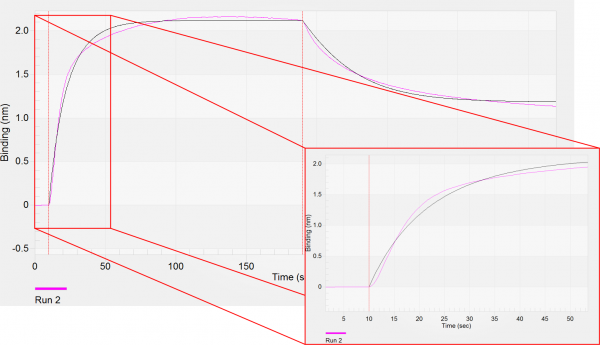This forum is intended for questions about kinetics, Surface Plasmon Resonance and the instruments related to these techniques.
Sigmoidal binding curver?
- gebauer
- Topic Author
- New Member
-

Less
More
- Thank you received: 0
7 years 10 months ago #1
by gebauer
Sigmoidal binding curver? was created by gebauer
Hi,
let me shortly introduce myself as I am new in this forum. I am PhD, working primarly with xray crystallography. However, I also have a solid epxierence in measuring binding kinetics using biacore and biolayer interferometrie (BLItz).
In the later i recently got a binding curver from a co-worker for analysis, which I found peculiar. It has sigmoidal shape instead of an exponentinal. It is well conciveable that the binding needs some structural rearrangment and is cooperative... Could this explain the curves? (I have more). Is there any publication on analysis of this type of data?
Best,
Jan
let me shortly introduce myself as I am new in this forum. I am PhD, working primarly with xray crystallography. However, I also have a solid epxierence in measuring binding kinetics using biacore and biolayer interferometrie (BLItz).
In the later i recently got a binding curver from a co-worker for analysis, which I found peculiar. It has sigmoidal shape instead of an exponentinal. It is well conciveable that the binding needs some structural rearrangment and is cooperative... Could this explain the curves? (I have more). Is there any publication on analysis of this type of data?
Best,
Jan
Please Log in or Create an account to join the conversation.
- Arnoud
- Moderator
-

Less
More
- Thank you received: 0
7 years 10 months ago #2
by Arnoud
Replied by Arnoud on topic Sigmoidal binding curver?
Hi Jan,
For me the first striking thing is the dissociation which starts fast and then becomes slow. This can point to a heterogeneous or biphasic interaction. Since there is no information what is measured (single protein, IgG, possible interaction stoichiometry’s) it is difficult to give a better answer.
I never worked with any cooperativity so I cannot help you with it.
Two publications I found that could be helpful.
1. Lebedev K, Mafé S, Stroeve P. Convection, diffusion and reaction in a surface-based biosensor: Modeling of cooperativity and binding site competition on the surface and in the hydrogel. Journal of Colloid and Interface Science. 2006;296(2):527-37.
2. Rufer A, Neuenschwander PF, Sauer B. Analysis of Cre-loxP interaction by surface plasmon resonance: influence of spermidine on cooperativity. Analytical Biochemistry. 2002;308(1):90-9.
Kind regards
Arnoud
For me the first striking thing is the dissociation which starts fast and then becomes slow. This can point to a heterogeneous or biphasic interaction. Since there is no information what is measured (single protein, IgG, possible interaction stoichiometry’s) it is difficult to give a better answer.
I never worked with any cooperativity so I cannot help you with it.
Two publications I found that could be helpful.
1. Lebedev K, Mafé S, Stroeve P. Convection, diffusion and reaction in a surface-based biosensor: Modeling of cooperativity and binding site competition on the surface and in the hydrogel. Journal of Colloid and Interface Science. 2006;296(2):527-37.
2. Rufer A, Neuenschwander PF, Sauer B. Analysis of Cre-loxP interaction by surface plasmon resonance: influence of spermidine on cooperativity. Analytical Biochemistry. 2002;308(1):90-9.
Kind regards
Arnoud
Please Log in or Create an account to join the conversation.
- gebauer
- Topic Author
- New Member
-

Less
More
- Thank you received: 0
7 years 10 months ago #3
by gebauer
Replied by gebauer on topic Sigmoidal binding curver?
Hi Arnoud,
sorry for the late reply... but we are moving our research group and therefore I am quite busy with organisation.
You are right the dissociation looks also a little bit weird.
To give you more information:
An biotinylated oligo was coupled on a BLItz-sensor and incubated with a transcription factor. It is believed that these transcription factor do bind as dimers, which form on the DNA (thus me speculated cooperativity effect). For me this could explain the first slow and than faster kobs, but not so much your initial fast koff ...
I will definitely check out the publications you cited!
With kind regards,
Jan
sorry for the late reply... but we are moving our research group and therefore I am quite busy with organisation.
You are right the dissociation looks also a little bit weird.
To give you more information:
An biotinylated oligo was coupled on a BLItz-sensor and incubated with a transcription factor. It is believed that these transcription factor do bind as dimers, which form on the DNA (thus me speculated cooperativity effect). For me this could explain the first slow and than faster kobs, but not so much your initial fast koff ...
I will definitely check out the publications you cited!
With kind regards,
Jan
Please Log in or Create an account to join the conversation.
Moderators: Arnoud, Arnoud
